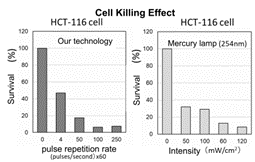Advantages
- Eco-friendly because it does not use mercury.
- It is inexpensive and has a simple structure without using expensive rare gases and halogen unlike halogen lamps.
- It can be used for sterilization / purification / semiconductor annealing / resin curing, etc.
Background and Technology
As conventional ultraviolet lamps, mercury lamps for sterilization and excimer lamps using rare gas and halogen are used. Mercury lamps have an emission spectrum of 254 nm and are effective for sterilization, but because they use mercury, they impose an environmental burden at the time of disposal. Excimer lamps have different wavelengths depending on the medium, but for example, the KrCl excimer has a center wavelength of light emission at 222 nm. Excimer lamps use expensive rare gases (Kr and Xe) and halogens as discharge media, and their structures are complicated.
The deep ultraviolet light source of the present invention uses an inexpensive and easily available discharge gas. High-voltage pulse power supplies have an initial cost, but running is cheap. Since the structure is simple and the environmental load is low, it seems to have an advantage over conventional mercury lamps and excimer lamps. Further, although deep ultraviolet LEDs have been developed, manufactured, and sold, the light source of the present invention has an advantage in light emission intensity.
 |
 |
Reference and Patent
- Patent pending (unpublished)
Principal Investigator
Takashi Sakugawa, Prof. (Institute of Industrial Nanomaterials, Kumamoto University)
Current Stage and Next Step
- Concept proven using prototype.
- We plan to study more optimal plasma media and discharge conditions and to reduce the voltage.
- We are looking for partner companies to collaborate on practical research and development of this technology.
- Feasibility studies are possible by disclosing plasma media and discharge conditions under a nondisclosure agreement.
Project No. BK-04021


